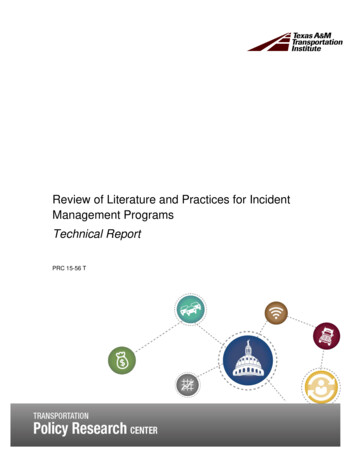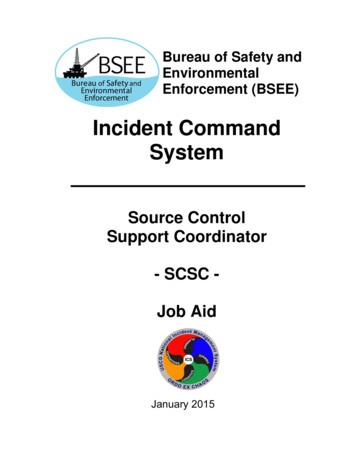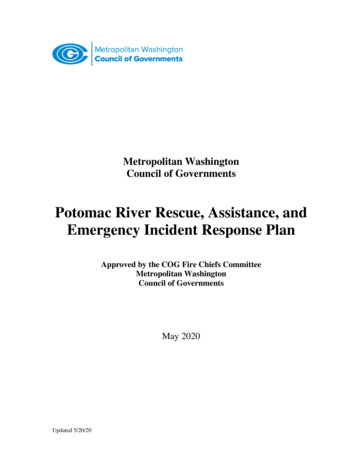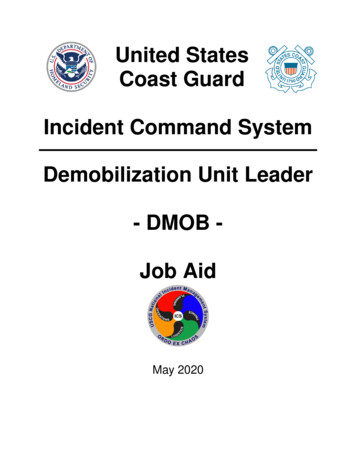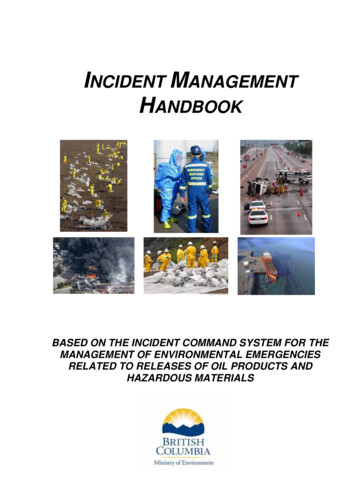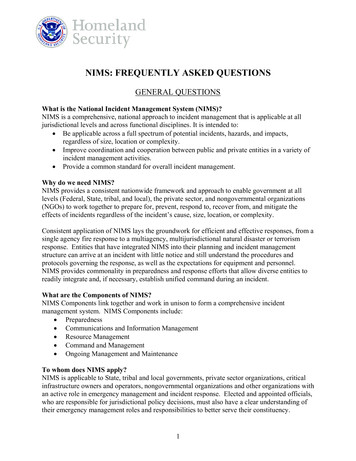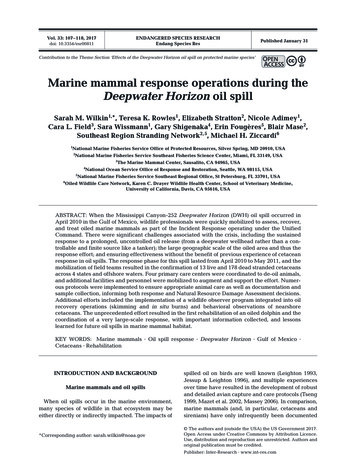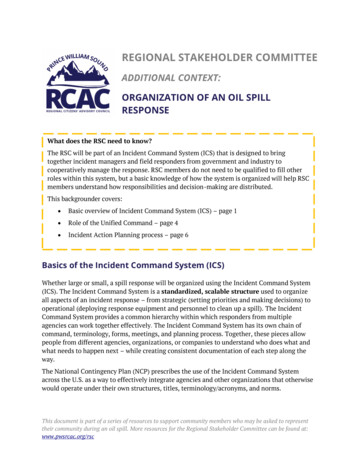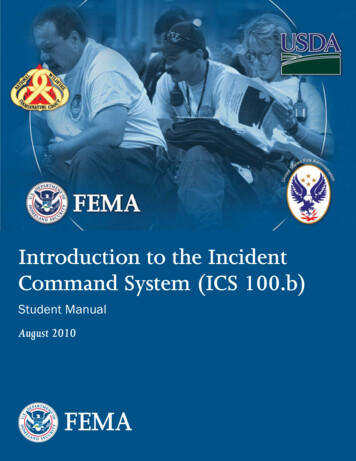
Transcription
Introduction to the IncidentCommand System (ICS 100.b)Student ManualAugust 2010
UNIT 1: COURSE OVERVIEW
This page intentionally left blank
Unit 1: Course OverviewCOURSE INTRODUCTIONVisual 1.1Key PointsWelcome to the course.This course will introduce you to the Incident Command System (ICS).August 2010IS-100.b – Introduction to the Incident Command System (ICS)Student ManualPage 1.1
Unit 1: Course OverviewCOURSE GOALS AND OBJECTIVESVisual 1.2Key PointsThe goals for this course are for you to: Demonstrate basic knowledge of the Incident Command System (ICS).Be prepared to coordinate with response partners from all levels of government and theprivate sector.This course is designed to provide overall incident management skills rather than tacticalexpertise. Additional courses are available on developing and implementing incident tactics.Page 1.2IS-100.b – Introduction to the Incident Command System (ICS)Student ManualAugust 2010
Unit 1: Course OverviewCOURSE GOAL AND OBJECTIVESVisual 1.3Key PointsAt the completion of the course, you should be familiar with: ICS applications.ICS organizational principles and elements.ICS positions and responsibilities.ICS facilities and functions.ICS planning.August 2010IS-100.b – Introduction to the Incident Command System (ICS)Student ManualPage 1.3
Unit 1: Course OverviewINTRODUCTIONS AND EXPECTATIONSVisual 1.4Key PointsIntroduce yourself by providing: Your name.Your job title.A brief statement of your overall experience with emergency or incident response.Your possible roles in responding to incidents.Page 1.4IS-100.b – Introduction to the Incident Command System (ICS)Student ManualAugust 2010
Unit 1: Course OverviewINTRODUCTIONS AND EXPECTATIONSVisual 1.5Key PointsWhat do you expect to gain from this course?August 2010IS-100.b – Introduction to the Incident Command System (ICS)Student ManualPage 1.5
Unit 1: Course OverviewINTRODUCTIONS AND EXPECTATIONSVisual 1.6Key PointsThe instructors expect that everyone will: Cooperate with the group.Be open minded to new ideas.Participate actively in all of the training activities and exercises.Return to class at the stated time.Use what they learn in the course to perform effectively within an ICS organization.Page 1.6IS-100.b – Introduction to the Incident Command System (ICS)Student ManualAugust 2010
Unit 1: Course OverviewCOURSE STRUCTUREVisual 1.7Key PointsThe course is divided into the following seven units: Unit 1:Unit 2:Unit 3:Unit 4:Unit 5:Unit 6:Unit 7:Course OverviewICS OverviewICS Features and PrinciplesIncident Commander and Command Staff FunctionsGeneral Staff FunctionsUnified CommandCourse Summary – Putting It All TogetherAugust 2010IS-100.b – Introduction to the Incident Command System (ICS)Student ManualPage 1.7
Unit 1: Course OverviewCOURSE LOGISTICSVisual 1.8Key PointsReview the following information: Course agendaSign-in sheetReview the following housekeeping issues: BreaksMessage and telephone locationCell phone policyFacilitiesOther concernsThe course glossary is located at the end of this unit, and should be used throughout thecourse. Some of the terms in the glossary may be used differently in ICS than in day-to-dayoperations (e.g., facilities).Page 1.8IS-100.b – Introduction to the Incident Command System (ICS)Student ManualAugust 2010
Unit 1: Course OverviewCOURSE COMPLETIONVisual 1.9Key PointsIn order to successfully complete this course, you must: Participate in unit activities/exercises.Achieve 75% or higher on the final exam.Complete the end-of-course evaluation.August 2010IS-100.b – Introduction to the Incident Command System (ICS)Student ManualPage 1.9
ICS: GlossaryAgency: A division of government with a specific function offering a particular kind of assistance. In theIncident Command System, agencies are defined either as jurisdictional (having statutory responsibilityfor incident management) or as assisting or cooperating (providing resources or other assistance).Governmental organizations are most often in charge of an incident, though in certain circumstancesprivate sector organizations may be included. Additionally, nongovernmental organizations may beincluded to provide support.Agency Administrator or Executive: The official responsible for administering policy for an agency orjurisdiction. An Agency Administrator/Executive (or other public official with jurisdictional responsibility forthe incident) usually makes the decision to establish an Area Command.Agency Dispatch: The agency or jurisdictional facility from which resources are sent to incidents.Agency Representative: A person assigned by a primary, assisting, or cooperating Federal, State,tribal, or local government agency or private organization that has been delegated authority to makedecisions affecting that agency's or organization's participation in incident management activities followingappropriate consultation with the leadership of that agency.All-Hazards: Describing an incident, natural or manmade, that warrants action to protect life, property,environment, public health or safety, and minimize disruptions of government, social, or economicactivities.Allocated Resource: Resource dispatched to an incident.Area Command: An organization established to oversee the management of multiple incidents that areeach being handled by a separate Incident Command System organization or to oversee themanagement of a very large or evolving incident that has multiple incident management teams engaged.An agency administrator/executive or other public official with jurisdictional responsibility for the incidentusually makes the decision to establish an Area Command. An Area Command is activated only ifnecessary, depending on the complexity of the incident and incident management span-of-controlconsiderations.Assessment: The process of acquiring, collecting, processing, examining, analyzing, evaluating,monitoring, and interpreting the data, information, evidence, objects, measurements, images, sound, etc.,whether tangible or intangible, to provide a basis for decisionmaking.Assigned Resource: Resource checked in and assigned work tasks on an incident.Assignment: Task given to a personnel resource to perform within a given operational period that isbased on operational objectives defined in the Incident Action Plan.Assistant: Title for subordinates of the Command Staff positions. The title indicates a level of technicalcapability, qualifications, and responsibility subordinate to the primary positions. Assistants may also beassigned to Unit Leaders.Assisting Agency: An agency or organization providing personnel, services, or other resources to theagency with direct responsibility for incident management.Available Resource: Resource assigned to an incident, checked in, and available for a missionassignment, normally located in a Staging Area.Badging: The assignment of physical incident-specific credentials to establish legitimacy and limitaccess to various incident sites.Branch: The organizational level having functional or geographical responsibility for major aspects ofincident operations. A Branch is organizationally situated between the Section Chief and the Division orAugust 2010IS-100.b – Introduction to the Incident Command System (ICS)Student ManualPage 1
ICS: GlossaryGroup in the Operations Section, and between the Section and Units in the Logistics Section. Branchesare identified by the use of Roman numerals or by functional area.Cache: A predetermined complement of tools, equipment, and/or supplies stored in a designatedlocation, available for incident use.Camp: A geographical site, within the general incident area, separate from the Incident Base, equippedand staffed to provide sleeping, food, water, and sanitary services to incident personnel.Certifying Personnel: The process of authoritatively attesting that individuals meet professionalstandards for the training, experience, and performance required for key incident management functions.Chain of Command: The orderly line of authority within the ranks of the incident managementorganization.Check-In: The process through which resources first report to an incident. All responders, regardless ofagency affiliation, must report in to receive an assignment in accordance with the procedures establishedby the Incident Commander.Chief: The Incident Command System title for individuals responsible for management of functionalSections: Operations, Planning, Logistics, Finance/Administration, and Intelligence/Investigations (ifestablished as a separate Section).Command: The act of directing, ordering, or controlling by virtue of explicit statutory, regulatory, ordelegated authority.Command Staff: The staff who report directly to the Incident Commander, including the PublicInformation Officer, Safety Officer, Liaison Officer, and other positions as required. They may have anassistant or assistants, as needed.Common Operating Picture: An overview of an incident by all relevant parties that provides incidentinformation enabling the Incident Commander/Unified Command and any supporting agencies andorganizations to make effective, consistent, and timely decisions.Common Terminology: Normally used words and phrases—avoiding the use of different words/phrasesfor same concepts—to ensure consistency and to allow diverse incident management and supportorganizations to work together across a wide variety of incident management functions and hazardscenarios.Communications: The process of transmission of information through verbal, written, or symbolicmeans.Communications/Dispatch Center: An agency or interagency dispatcher center, 911 call center,emergency control or command dispatch center, or any naming convention given to the facility and staffthat handles emergency calls from the public and communication with emergency management/responsepersonnel. The center can serve as a primary coordination and support element of the multiagencycoordination system (MACS) for an incident until other elements of the MACS are formally established.Complex: Two or more individual incidents located in the same general area and assigned to a singleIncident Commander or to Unified Command.Cooperating Agency: An agency supplying assistance other than direct operational or support functionsor resources to the incident management effort.Coordinate: To advance systematically an analysis and exchange of information among principals whohave or may have a need to know certain information to carry out specific incident managementresponsibilities.Page 2IS-100.b – Introduction to the Incident Command System (ICS)Student ManualAugust 2010
ICS: GlossaryCorrective Actions: The implementation of procedures that are based on lessons learned from actualincidents or from training and exercises.Credentialing: The authentication and verification of the certification and identity of designated incidentmanagers and emergency responders.Delegation of Authority: A statement provided to the Incident Commander by the agency executivedelegating authority and assigning responsibility. The delegation of authority can include objectives,priorities, expectations, constraints, and other considerations or guidelines, as needed. Many agenciesrequire written delegation of authority to be given to the Incident Commander prior to assuming commandon larger incidents. Also known as Letter of Expectation.Demobilization: The orderly, safe, and efficient return of an incident resource to its original location andstatus.Deputy: A fully qualified individual who, in the absence of a superior, could be delegated the authority tomanage a functional operation or perform a specific task. In some cases, a Deputy could act as relief fora superior and therefore must be fully qualified in the position. Deputies can be assigned to the IncidentCommander, General Staff, and Branch Directors.Director: The Incident Command System title for individuals responsible for supervision of a Branch.Dispatch: The ordered movement of a resource or resources to an assigned operational mission, or anadministrative move from one location to another.Division: The organizational level having responsibility for operations within a defined geographic area.Divisions are established when the number of resources exceeds the manageable span of control of theSection Chief. See Group.Emergency: Any incident, whether natural or manmade, that requires responsive action to protect life orproperty. Under the Robert T. Stafford Disaster Relief and Emergency Assistance Act, an emergencymeans any occasion or instance for which, in the determination of the President, Federal assistance isneeded to supplement State and local efforts and capabilities to save lives and to protect property andpublic health and safety, or to lessen or avert the threat of a catastrophe in any part of the United States.Emergency Management/Response Personnel: Includes Federal, State, territorial, tribal, substateregional, and local governments, private-sector organizations, critical infrastructure owners and operators,nongovernmental organizations, and all other organizations and individuals who assume an emergencymanagement role. Also known as emergency responders.Emergency Operations Center (EOC): The physical location at which the coordination of informationand resources to support incident management (on-scene operations) activities normally takes place. AnEOC may be a temporary facility or may be located in a more central or permanently established facility,perhaps at a higher level of organization within a jurisdiction. EOCs may be organized by majorfunctional disciplines (e.g., fire, law enforcement, and medical services), by jurisdiction (e.g., Federal,State, regional, tribal, city, county), or some combination thereof.Emergency Operations Plan (EOP): An ongoing plan for responding to a wide variety of potentialhazards.Emergency Public Information: Information that is disseminated primarily in anticipation of anemergency or during an emergency. In addition to providing situational information to the public, it alsofrequently provides directive actions required to be taken by the general public.Evacuation: The organized, phased, and supervised withdrawal, dispersal, or removal of civilians fromdangerous or potentially dangerous areas, and their reception and care in safe areas.August 2010IS-100.b – Introduction to the Incident Command System (ICS)Student ManualPage 3
ICS: GlossaryEvent: See Planned Event.External Affairs: Organizational element that provides accurate, coordinated, and timely information toaffected audiences, including governments, media, the private sector, and the local populace.Federal: Of or pertaining to the Federal Government of the United States of America.Field Operations Guide: Durable pocket or desk guide that contains essential information required toperform specific assignments or functions.Finance/Administration Section: The Incident Command System Section responsible for alladministrative and financial considerations surrounding an incident.Function: One of the five major activities in the Incident Command System: Command, Operations,Planning, Logistics, and Finance/Administration. A sixth function, Intelligence/Investigations, may beestablished, if required, to meet incident management needs. The term function is also used whendescribing the activity involved (e.g., the planning function).General Staff: A group of incident management personnel organized according to function and reportingto the Incident Commander. The General Staff normally consists of the Operations Section Chief,Planning Section Chief, Logistics Section Chief, and Finance/Administration Section Chief. AnIntelligence/Investigations Chief may be established, if required, to meet incident management needs.Group: An organizational subdivision established to divide the incident management structure intofunctional areas of operation. Groups are composed of resources assembled to perform a specialfunction not necessarily within a single geographic division. See Division.Hazard: Something that is potentially dangerous or harmful, often the root cause of an unwantedoutcome.Identification and Authentication: For security purposes, process required for individuals andorganizations that access the National Incident Management System information management systemand, in particular, those that contribute information to the system (e.g., situation reports).Incident: An occurrence or event, natural or manmade, that requires a response to protect life orproperty. Incidents can, for example, include major disasters, emergencies, terrorist attacks, terroristthreats, civil unrest, wildland and urban fires, floods, hazardous materials spills, nuclear accidents, aircraftaccidents, earthquakes, hurricanes, tornadoes, tropical storms, tsunamis, war-related disasters, publichealth and medical emergencies, and other occurrences requiring an emergency response.Incident Action Plan (IAP): An oral or written plan containing general objectives reflecting the overallstrategy for managing an incident. It may include the identification of operational resources andassignments. It may also include attachments that provide direction and important information formanagement of the incident during one or more operational periods.Incident Base: The location at which primary Logistics functions for an incident are coordinated andadministered. There is only one Base per incident. (Incident name or other designator will be added tothe term Base.) The Incident Command Post may be co-located with the Incident Base.Incident Command: The Incident Command System organizational element responsible for overallmanagement of the incident and consisting of the Incident Commander (either single or unified commandstructure) and any assigned supporting staff.Incident Commander (IC): The individual responsible for all incident activities, including thedevelopment of strategies and tactics and the ordering and the release of resources. The IC has overallauthority and responsibility for conducting incident operations and is responsible for the management ofall incident operations at the incident site.Page 4IS-100.b – Introduction to the Incident Command System (ICS)Student ManualAugust 2010
ICS: GlossaryIncident Command Post (ICP): The field location where the primary functions are performed. The ICPmay be co-located with the Incident Base or other incident facilities.Incident Command System (ICS): A standardized on-scene emergency management constructspecifically designed to provide for the adoption of an integrated organizational structure that reflects thecomplexity and demands of single or multiple incidents, without being hindered by jurisdictionalboundaries. ICS is the combination of facilities, equipment, personnel, procedures, and communicationsoperating within a common organizational structure, designed to aid in the management of resourcesduring incidents. It is used for all kinds of emergencies and is applicable to small as well as large andcomplex incidents. ICS is used by various jurisdictions and functional agencies, both public and private,to organize field-level incident management operations.Incident Management: The broad spectrum of activities and organizations providing effective andefficient operations, coordination, and support applied at all levels of government, utilizing bothgovernmental and nongovernmental resources to plan for, respond to, and recover from an incident,regardless of cause, size, or complexity.Incident Management Team (IMT): An Incident Commander and the appropriate Command andGeneral Staff personnel assigned to an incident. The level of training and experience of the IMTmembers, coupled with the identified formal response requirements and responsibilities of the IMT, arefactors in determining “type,” or level, of IMT.Incident Objectives: Statements of guidance and direction needed to select appropriate strategy(s) andthe tactical direction of resources. Incident objectives are based on realistic expectations of what can beaccomplished when all allocated resources have been effectively deployed. Incident objectives must beachievable and measurable, yet flexible enough to allow strategic and tactical alternatives.Information Management: The collection, organization, and control over the structure, processing, anddelivery of information from one or more sources and distribution to one or more audiences who have astake in that information.Initial Action: An action taken by those responders first to arrive at an incident site.Initial Response: Resources initially committed to an incident.Intelligence/Investigations: An organizational subset within ICS. Intelligence gathered within theIntelligence/Investigations function is information that either leads to the detection, prevention,apprehension, and prosecution of criminal activities—or the individual(s) involved—including terroristincidents or information that leads to determination of the cause of a given incident (regardless of thesource) such as public health events or fires with unknown origins. This is different from the normaloperational and situational intelligence gathered and reported by the Planning Section.Interoperability: Ability of systems, personnel, and equipment to provide and receive functionality, data,information and/or services to and from other systems, personnel, and equipment, between both publicand private agencies, departments, and other organizations, in a manner enabling them to operateeffectively together. Allows emergency management/response personnel and their affiliatedorganizations to communicate within and across agencies and jurisdictions via voice, data, or video-ondemand, in real time, when needed, and when authorized.Job Aid: Checklist or other visual aid intended to ensure that specific steps of completing a task orassignment are accomplished.Joint Information Center (JIC): A facility established to coordinate all incident-related public informationactivities. It is the central point of contact for all news media at the scene of the incident. Publicinformation officials from all participating agencies should co-locate at the JIC.August 2010IS-100.b – Introduction to the Incident Command System (ICS)Student ManualPage 5
ICS: GlossaryJoint Information System (JIS): A structure that integrates incident information and public affairs into acohesive organization designed to provide consistent, coordinated, accurate, accessible, timely, andcomplete information during crisis or incident operations. The mission of the JIS is to provide a structureand system for developing and delivering coordinated interagency messages; developing,recommending, and executing public information plans and strategies on behalf of the IncidentCommander (IC); advising the IC concerning public affairs issues that could affect a response effort; andcontrolling rumors and inaccurate information that could undermine public confidence in the emergencyresponse effort.Jurisdiction: A range or sphere of authority. Public agencies have jurisdiction at an incident related totheir legal responsibilities and authority. Jurisdictional authority at an incident can be political orgeographical (e.g., city, county, tribal, State, or Federal boundary lines) or functional (e.g., lawenforcement, public health).Jurisdictional Agency: The agency having jurisdiction and responsibility for a specific geographicalarea, or a mandated function.Key Resource: Any publicly or privately controlled resource essential to the minimal operations of theeconomy and government.Letter of Expectation: See Delegation of Authority.Liaison: A form of communication for establishing and maintaining mutual understanding andcooperation.Liaison Officer (LNO): A member of the Command Staff responsible for coordinating withrepresentatives from cooperating and assisting agencies or organizations.Local Government: Public entities responsible for the security and welfare of a designated area asestablished by law. A county, municipality, city, town, township, local public authority, school district,special district, intrastate district, council of governments (regardless of whether the council ofgovernments is incorporated as a nonprofit corporation under State law), regional or interstategovernment entity, or agency or instrumentality of a local government; an Indian tribe or authorized tribalentity, or in Alaska a Native Village or Alaska Regional Native Corporation; a rural community,unincorporated town or village, or other public entity. See Section 2 (10), Homeland Security Act of 2002,Pub. L. 107-296, 116 Stat. 2135 (2002).Logistics: The process and procedure for providing resources and other services to support incidentmanagement.Logistics Section: The Incident Command System Section responsible for providing facilities, services,and materials for the incident.Management by Objectives: A management approach that involves a five-step process for achievingthe incident goal. The Management by Objectives approach includes the following: establishingoverarching incident objectives; developing strategies based on overarching incident objectives;developing and issuing assignments, plans, procedures, and protocols; establishing specific, measurabletactics or tasks for various incident management functional activities and directing efforts to attain them,in support of defined strategies; and documenting results to measure performance and facilitatecorrective action.Manager: Individual within an Incident Command System organizational unit who is assigned specificmanagerial responsibilities (e.g., Staging Area Manager or Camp Manager).Metric: A measurable standard, useful in describing a resource's capability.Page 6IS-100.b – Introduction to the Incident Command System (ICS)Student ManualAugust 2010
ICS: GlossaryMission Assignment: The mechanism used to support Federal operations in a Stafford Act majordisaster or emergency declaration. It orders immediate, short-term emergency response assistancewhen an applicable State or local government is overwhelmed by the event and lacks the capability toperform, or contract for, the necessary work. See also Pre-Scripted Mission Assignment.Mitigation: Activities providing a critical foundation in the effort to reduce the loss of life and propertyfrom natural and/or manmade disasters by avoiding or lessening the impact of a disaster and providingvalue to the public by creating safer communities. Mitigation seeks to fix the cycle of disaster damage,reconstruction, and repeated damage. These activities or actions, in most cases, will have a long-termsustained effect.Mobilization: The process and procedures used by all organizations—Federal, State, tribal, and local—for activating, assembling, and transporting all resources that have been requested to respond to orsupport an incident.Mobilization Guide: Reference document used by organizations outlining agreements, processes, andprocedures used by all participating agencies/organizations for activating, assembling, and transportingresources.Multiagency Coordination (MAC) Group: A group of administrators or executives, or their appointedrepresentatives, who are typically authorized to commit agency resources and funds. A MAC Group canprovide coordinated decisionmaking and resource allocation among cooperating agencies, and mayestablish the priorities among incidents, harmonize agency policies, and provide strategic guidance anddirection to support incident management activities. MAC Groups may also be known as multiagencycommittees, emergency management committees, or as otherwise defined by the MultiagencyCoordination System.Multiagency Coordination Systems (MACS): A system that provides the architecture to supportcoordination for incident prioritization, critical resource allocation, communications systems integration,and information coordination. MACS assist agencies and organizations responding to an incident. Theelements of a MACS include facilities, equipment, personnel, procedures, and communications. Two ofthe most commonly used elements are Emergency Operations Centers and MAC Groups.Multijurisdictional Incident: An incident requiring action from multiple agencies that each havejurisdiction to manage certain aspects of an incident. In the Incident Command System, these incidentswill be managed under a Unified Command.Mutual Aid or Assistance Agreement: Written or oral agreement between and amongagencies/organizations and/or jurisdictions that provides a mechanism to quickly obtain emergencyassistance in the form of personnel, equipment, materials, and other associated services. The primaryobjective is to facilitate rapid, short-term deployment of emergency support prior to, during, and/or afteran incident.National: Of a nationwide character, including the Federal, State, tribal, and local aspects of governanceand policy.National Incident Management System (NIMS): A set of principles that provides a systematic,proactive approach guiding government agencies at all levels, nongovernmental organizations, and theprivate sector to work seamlessly to prevent, protect against, respond to, recover from, and mitigate theeffects of incidents, regardless of cause, size, location, or complexity, in order to reduce the loss of life orproperty and harm to the environment.National Response Framework (NRF): A guide to how the Nation conducts all-hazards response.Nongovernmental Organization (NGO): An entity with an association that is based on interests of itsmembers, individuals, or institutions. It is not created by a government, but it may work cooperatively withgovernment. Such organizations serve a public purpose, not a private benefit. Examples of NGOsAugust 2010IS-100.b – Introduction to the Incident Command System (ICS)Student ManualPage 7
ICS: Glossaryinclud
ICS: Glossary IS-100.b - Introduction to the Incident Command System (ICS) August 2010 Student Manual Page 1 Agency: A division of government with a specific function offering a particular kind of assistance.In the Incident Command System, agencies are defined either as jurisdictional (having statutory responsibility


